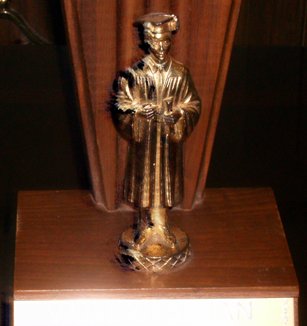Five of the six Golden Calf passages record gold, an inherently good substance created by God, being sinfully fashioned into an idol that was made in the likeness of a calf, an inherently good animal created by God (Exod. 32:4; Deut. 9:21; Neh. 9:18; Ps. 106:19; Acts 7:41). A careful consideration of both what Aaron and the people sinfully did on this occasion and the aftermath of their sinful actions illumines the debate about CCM.
Making a Golden Calf Was Not Inherently Wrong
Created by God, the gold that Aaron used to make the calf was a good substance in and of itself (cf. Gen. 2:12). Because God had also created calves, they were also good in and of themselves (cf. Gen. 1:24-25).
For an Israelite in Aaron’s day to make a golden calf, therefore, would not have been inherently an immoral action. This interpretation is confirmed by noting that God righteously commanded the Israelites later to make a bronze serpent (Num. 21:8-9), which was a human artistic creation (“Moses made a serpent of brass” [Num. 21:9]; italics added) patterned after something that God Himself had created.
Why Making the Golden Calf Was Wrong on This Occasion
Why then was it wrong for Aaron and the people to make the golden calf that they made on this occasion? A closer look at the biblical data points to several considerations.
How All the People Knew that Making an Idol Was Wrong
The Golden Calf passages reveal three ways that all the people knew that making the golden calf on this occasion was wrong. Taking into account each of these reasons is vital for a right understanding of their sinfulness on this occasion.
First, through natural revelation, all the people who were in Egypt at the time of the Exodus knew that making and worshiping idols was wrong (Rom. 1:18-23). In spite of their knowing with certainty that idolatry was wrong, the Egyptians at the time of the Exodus were an idolatrous people with many gods (cf. “gods” [Exod. 12:12]).
Second, in His plagues on Egypt, God judged all of Egypt’s gods (Exod. 12:12). All the people whom God brought out from Egypt further learned through these judgments that the idols of Egypt were sinful objects.
Third, God later warned the people whom He brought out of Egypt that they were not to make any graven images in the likeness of anything that was in the earth (Exod. 20:4) for the purpose of worshiping and serving them (Exod. 20:5). This revelation further instructed them that making and worshiping idols such as the ones that the Egyptians had made and worshiped was sinful.
For the first two reasons explained above, however, it is important to keep in mind that these people already knew conclusively that the idols that the Egyptians had made were sinful before they received this special revelation. They, therefore, would not have needed this revelation from God to know that making the golden calf was wrong.
How Aaron and the People Sinned Greatly by Making the Golden Calf
When Moses was absent from the people for an extended time, the people refused to obey him, repudiated him, and turned back in their hearts to Egypt (Acts 7:39). In rebellion against God and Moses, they demanded that Aaron would make for them “gods” (Acts 7:40; cf. “God” [Neh. 9:18]) to go before them.
Using the gold that the people provided him, Aaron and the people worked together to make the golden calf (Exod. 32:2-4; Acts 7:40). He brought a very great sin upon them through his role in this incident (Exod. 32:21).
The people sinned by making the calf in spite of all the ways that they knew that doing so was wrong, and they sinned further by proclaiming to Israel that these were her “gods” that brought her out of Egypt (Acts 7:40; Exod. 32:4; but cf. “God” [Neh. 9:18]). They did so in spite of their having seen God’s supernatural judgment of all the gods of Egypt (cf. Exod. 12:12) and knowing with certainty that He was the One who had brought them out of Egypt (cf. Exod. 14:31-15:21).
A Closer Look at Aaron’s Great Sinfulness in Making the Golden Calf
When Aaron fashioned the gold into a calf, what he did was very sinful (cf. “so great a sin” [Exod. 32:21]) for multiple reasons. First, it was sinful because it was done in disobedience to God’s command.
Second, it was very sinful because it was done to satisfy the demands of people whom God had redeemed out of Egypt who now in their hearts had sinfully gone back to Egypt. As one of God’s leaders, he should have sternly resisted their demands instead of giving them what they wanted.
Third, because Aaron had lived for many years among the Egyptians, he knew what their idolatrous worship was like and what the gods that they had worshiped looked like. He thus knew what would be an acceptable idol for people who had come out of Egypt.
His making the calf was thus also very sinful because he used his God-given creative powers to form a forbidden object that was patterned after what he knew was used by evil people for evil purposes. God’s profound anger with Aaron on this occasion (Deut. 9:20) undoubtedly stemmed in part from the sinfulness of his fashioning gold into a calf that he knew would be acceptable to them as an idol because it was similar to what they as wicked people had used previously in their evil worship.
Conclusion
Although they used an inherently good substance (gold) to create something in the likeness of a good animal that God had created, Aaron and those who made the golden calf sinned greatly against God by making the gold into an idol. Their sin also included fashioning the gold into an idol that was similar to the idols used by wicked people in their sinful practices.
In making the golden calf, Aaron and the people sinned profoundly in spite of their knowing in multiple ways that doing so was morally wrong. As we will see in future articles, this analysis of the Golden Calf incident has profound relevance for the CCM debate because similar considerations are vital for determining whether CCM use in corporate worship is acceptable to God.
For more on the Golden Calf incident, see the five preceding articles in this series under point 11 here.
Copyright © 2011-2024 by Rajesh Gandhi. All rights reserved.







